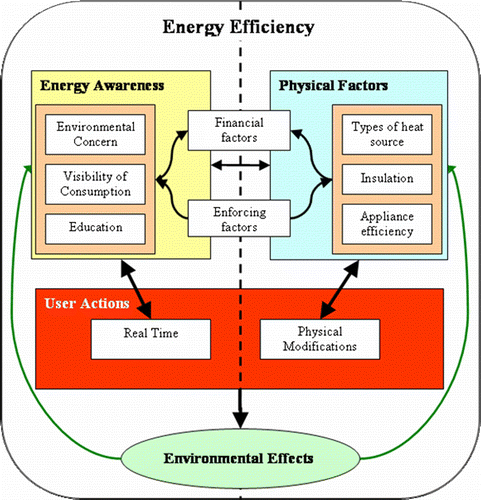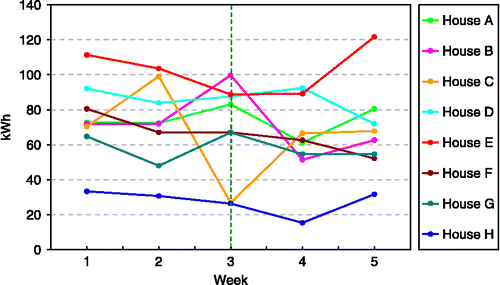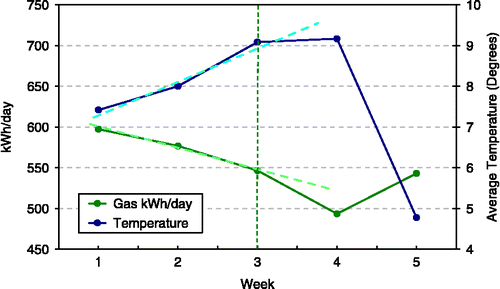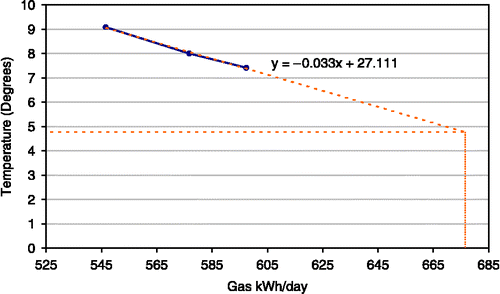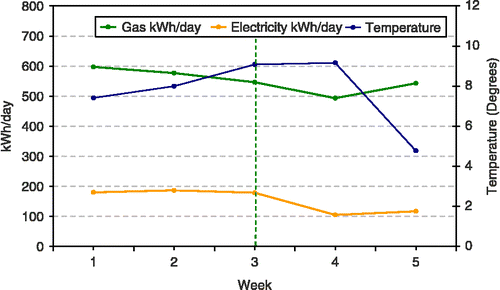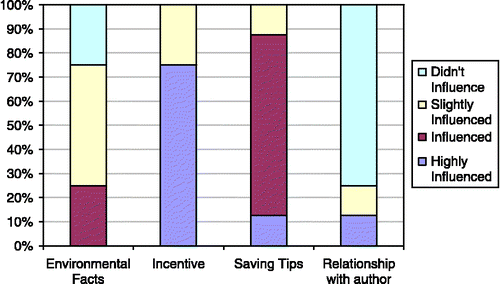Abstract
The increasing levels of global warming, depleting sources of fossil fuels and increasing energy costs are all having a large detrimental effect on today's society. Many efforts are being made to try and increase energy efficiency all over the world. One of the major problems is unnecessary and excessive energy utilisation. This problem has been identified by Loughborough University and they are making efforts to try and reduce energy wastage. One of their strategies, used up until recently, involved increasing energy awareness within students in halls of residence by means of a reward system called the Residential Halls Energy Efficiency League (Imago Services, Loughborough Students Union, Estates Services 2006). This scheme managed to reduce energy consumption by up to 10%, saving an estimated £9000 in only 52 days. Can those results be improved by targeting students more specifically? How much energy can be saved by increasing energy awareness?
1. Introduction
This study investigates the energy awareness of students within rented accommodation. It intends to discover what effect increasing energy awareness has on energy consumption (gas and electricity). The main aim is to calculate how much energy could be saved and whether introducing energy awareness methods would be economically viable.
A systems approachFootnote2 has been used to create/review ways of increasing energy awareness within the student population. These solutions have been assessed to see what effect they have on energy consumption.
1.1 Project drivers
1.1.1 Environmental issues
Global warming, or climate change, is caused by the increasing amount of carbon dioxide and other polluting gases in the atmosphere. These greenhouse gases are caused by the burning of fossil fuels. By trapping the sun's heat they cause the Earth's temperature to rise as shown in Figure . The increase in temperature is having devastating effects on the environment.
Figure 1 Graph showing the increase in the Earth's average global temperature in relation to the carbon dioxide emissions (Energy Information Administration, Citation2007a, Available from: www.cru.uea.ac.uk/cru/data/temperature).
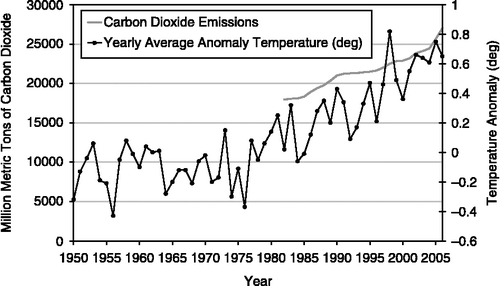
Rising sea levels are one example of the negative effects increasing temperature has. It is caused by great quantities of ice around the world melting coupled with the thermal expansion of the seaFootnote3. Small islands are already affected with flooding becoming more common (WBGU Special Report Citation2006). It is estimated that global average sea level will rise between 110 and 770 mm by 2100 (Intergovernmental Panel on Climate Change Citation2001). If sea levels rise by as little as 400 mm the amount of people at risk from salt water flooding will be more than double (Patz et al. Citation2005). This rise could also pollute the water supply of many low lying cities around the world possibly leading to their abandonment (Pearce Citation2005).
Climate scientists around the world believe that as little as a 2°C global temperature rise above pre-industrial levels could be the point of no return (Hare Citation2006, WBGU Special Report Citation2006). An increase of 2°C will cause ecosystems across the planet to shut down and start the total melting of Greenland ice (Monbiot Citation2006). Due to the effects of the temperature rise this point is where the Earth will no longer be able to recover from global warming and things will spiral out of control. Current predictions estimate that the Earth will reach this level by 2030 (Jones et al. Citation2003). To prevent the Earth from ever increasing its global temperature by 2°C greenhouse gas emissions will have to be cut to around 10% by 2030. In the UK, this means reductions of about 87% will be required (Monbiot Citation2006, Energy Information Administration Citation2007).
There is also the issue that fossil fuels, at the current rate are being depleted, may run out by 2100 (Available from: www.after-oil.co.uk [Accessed November 2006]). Figure shows that by as early as 2010 the supply of oil will never again match the demand.
Figure 2 Chart showing the annual production of fossil fuels including the estimated future values (Available from: www.after-oil.co.uk [Accessed November 2006]). (Figure available in colour online).
![Figure 2 Chart showing the annual production of fossil fuels including the estimated future values (Available from: www.after-oil.co.uk [Accessed November 2006]). (Figure available in colour online).](/cms/asset/d83e7ee3-1822-4eac-8dd9-15ebcbf0b276/tsue_a_412369_o_f0002g.gif)
Another factor, resulting from the depleting fossil fuel sources, is the rising price of energy. This has greatly affected the price of both gas and electricity for the domestic consumer as shown in Figure . Prices have more than doubled in the past 20 years.
Figure 3 Average US gas and electricity prices between 1974 and 2007 (Energy Information Administration Citation2007a).
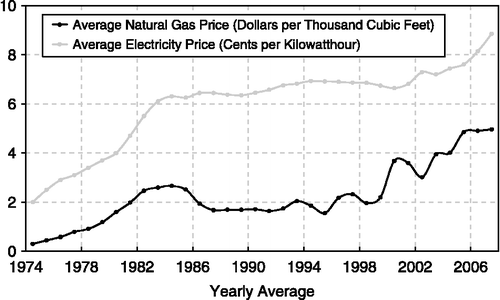
Consumers are being increasingly affected and are becoming more aware of the cost. An issue that will be discussed further in this report is the lack of knowledge that consumers have about energy. Even though they are becoming more aware of the cost they may not know how to reduce their gross expenditure due to lack of education.
With the world using increasing amounts of energy, as shown in Figure , these problems are getting worse. Increasing the efficiency awareness of domestic consumers would help reduce these effects.
Figure 4 Predicted world marketed energy use by energy type between 1980 and 2030 (Available from: www.after-oil.co.uk [Accessed November 2006]). (Figure available in colour online).
![Figure 4 Predicted world marketed energy use by energy type between 1980 and 2030 (Available from: www.after-oil.co.uk [Accessed November 2006]). (Figure available in colour online).](/cms/asset/04c47aa3-50ff-495d-8c0b-f3915988bc37/tsue_a_412369_o_f0004g.gif)
1.1.2 Government enforcement UK and worldwide
Governments around the world are becoming more concerned, aware and responsive to greenhouse gas emissions. The public's reaction to studies about climate change is making authorities take actions to combat the problem. With the UK already signed up to the Kyoto protocol it is already committed to reduce greenhouse gases (Available from: www.unfccc.int/kyoto_protocol/items/2830.php [Accessed January 2007]). There are many publications in the UK that aim and set guidelines to increase energy efficiency. One of these is the Energy White Paper 2003 whose main aim is a 60% reduction in carbon emissions by 2050 (Available from: www.dti.gov.uk/energy/policy-strategy/energy-white-paper-2003/page21223.html [Accessed November 2006]). There are more policies planned for the future that are going to be legally binding. The UK Climate Change Bill has just been published in draft. This bill will make the UK hit substantial targets of a ‘60% reduction by 2050 and a 26 to 32% reduction by 2020’ (Available from: www.defra.gov.uk/news/latest/2007/climate-0313.htm [Accessed April 2007]). This project aims to provide a financially viable option that will help the forthcoming required reduction in greenhouse gases.
1.2 Background
Initial plans for the project concentrated on reducing energy consumption within homes in the UK. Ideas about increasing energy awareness were adopted and used to create a proposal. Since then the project has evolved due to a number of factors. The main concern with the original project was the extremely broad range of users and scope that it could entail. The evaluation of its outcome would have been difficult to judge.
To reduce the targeted population the student section of the energy market was chosen.
1.3 Target population
This study is targeted at students between the age of 18 and 24 who are undertaking an undergraduate course.
The targeted population was selected due to the author's first hand experience living in student accommodation for nearly 5 years. This experience highlighted the deficient energy awareness within the student population.
Targeting university students is a great way to reduce energy consumption as they are the highest consumers in the domestic sector (Imago Services, Loughborough Students Union, Estates Services Citation2006). Also, if energy awareness is taught to people at an early age they are more likely to carry it throughout their life therefore having a greater effect on the future.
1.4 Targeted energy supply
This project investigates the energy consumption of gas and electricity within the target population of undergraduates in a selected area, by reducing the boundaries of this project even further it aids the creation of a more detailed and unambiguous outcome.
1.5 Objectives
The project's aims, listed below, were set out at the beginning and provided a backbone for the research and analysis that has been conducted.
| 1. | To undertake a literature review about previous/current energy reducing schemes. | ||||||||||||||||
| 2. | Define energy awareness and energy efficiency and discover how they affect each other. | ||||||||||||||||
| 3. | Identify and create relevant methods to increase energy awareness in the student population. | ||||||||||||||||
| 4. | Undertake a trial, on the population, that imposes the ideas created to see if they work:
| ||||||||||||||||
| 5. | Relate the results from the trial to a real world situation. | ||||||||||||||||
| 6. | Use the data found to answer the hypothesis/question. | ||||||||||||||||
1.6 Paper structure
The report has been split into three sections. The first part contains a model of student energy efficiency and how it relates to energy awareness.
Section 2 evaluates energy awareness techniques, highlighting the main energy awareness factors that will have the greatest effects on students.
Section 3 describes and evaluates a trial that was conducted on students to test the energy awareness factors created.
2. Energy efficiency model
Energy efficiency is the ratio of energy used to the actual energy needed. Consumers in the UK are estimated to be the worst energy savers in Europe (Available from: www.which.co.uk/reports_and_campaigns/house_and_home/Reports/environment/Energy_wasting_brits_news_article_557_98018.jsp [Accessed January 2007]). There are many different schemes that help increase energy efficiency; these will be discussed later.
To understand an individual's energy efficiency all the varying factors need to be investigated. The energy efficiency model created for domestic consumers is shown in Figure . This model is described in the following sections and then related specifically to the student sector in part III of this report.
Figure 5 Energy efficiency model. This shows the interaction between all the factors that affect an individual's energy efficiency.
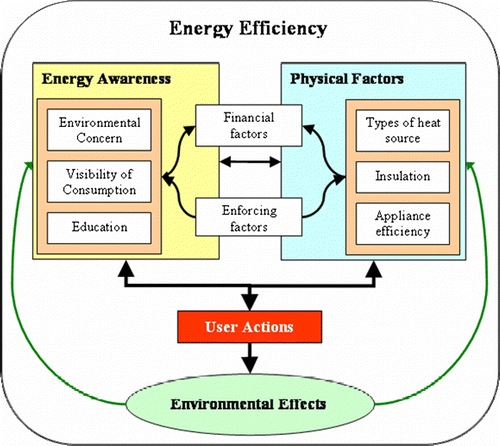
2.1 Energy awareness
Energy awareness is the understanding of energy consumption. In relation to this study, awareness in residential buildings is centred on the consumption of gas and electricity. It involves knowing how much energy appliances use, how efficient they are and how activities affect energy consumption.
Energy awareness is effected by a number of factors. One of these factors is the visibility of energy consumption. It has been estimated that increased visibility can reduce energy consumption by up to 20% (Available from: www.electrabel.be/smallmedium/productsandservices/enerlutionvision_en.asp [Accessed April 2007]).
Factors that increase energy awareness by their nature are financial and enforcing ones. Depending on how financially concerned occupants are greatly effects energy consumption. Where students have an all inclusive package with their tenancy agreement (the rent includes energy bills) their energy awareness may reduce substantially. This will in turn drastically reduce their energy efficiency.
Enforcing factors have not been employed in the UK, but plans for their arrival are imminent. Their introduction will drastically increase consumer's energy awareness and efficiency by making them adhere to the requirements.
Environmental impacts may also increase energy awareness as more people are starting to think about what effect their energy use has on the environment. This factor varies and very much depends on how ecologically minded an individual is (Available from: www.defra.gov.uk/environment/energy/index.htm [Accessed December 2006]).
2.2 Physical factors
There are huge amounts of energy saving measures that home owners could apply to increase energy efficiency.
The list below details the most common and effective physical changes that could be made to a house:
| • | Increase insulation: Loft, cavity wall, reflective material behind radiators, hot water tank jacket, draught proofing, double glazing, etc. | ||||
| • | Use energy saving appliances: Energy saving light bulbs, energy efficient washing machines/boilers – buy ‘energy saving recommended logo’ products, etc. | ||||
The UK government funds such energy efficiency improvements by up to £2700.
Sometimes it is not financially viable to make a building more energy efficient, therefore the efficiency properties of a residence may be affected by financial and enforcing factors. An example of enforcing measures are the laws that are being introduced to prevent the sale of inefficient appliances; in England and Wales new gas boilers must now be of high efficiency that offer a saving of up to a third of the heating bills.
2.3 User actions
This section discusses real time use of energy and the modifications that a resident may decide to make to a building.
Studies across the world have shown that domestic energy consumption per person is very different. Decisions that humans make greatly affect energy consumption.
Increasing energy efficiency can be achieved by the following actions:
| • | turning lights off when not in use; | ||||
| • | turning appliances off when not in use – including appliances on standby; | ||||
| • | unplugging chargers when not in use; | ||||
| • | only boil the amount of water needed; | ||||
| • | wash clothes at 30°C; | ||||
| • | put lids on pans when cooking; | ||||
| • | turning the thermostat down; | ||||
| • | closing curtains at dusk; | ||||
| • | fix dripping taps; and | ||||
| • | do not heat water to more than 60°C. | ||||
As discussed in the previous section, the physical characteristics of a building and its contents govern how efficient it is. Since the user has control over these factors this should be included in the user actions section. The energy efficiency model has been modified to include the detailed user actions as shown in Figure .
2.4 Energy efficiency summary
Students in rented accommodation have little control over changing the physical energy efficiency of a building. This would imply that there is a limiting factor when trying to increase a student's energy efficiency. Studies suggest that up to 50% of domestic energy use is controlled by the occupants' activities (Schipper Citation1989). The other half involves the buildings physical characteristics including insulation and appliance efficiency, etc. emphasising that even though students' energy efficiency is limited it can still be increased substantially by targeting their activities within the residence. The dotted line in Figure shows the 50/50 split of efficiency factors.
This was shown by an experiment in Sweden in 1977 where energy measurements were taken from similar families in virtually identical houses (Schipper Citation1989). Since the houses had the same energy efficiency the results showed that other factors influenced household energy use. Total electricity used varied extensively at a given income, so the financial factor could also be ignored. These results again point to the explanation that it is personal characteristics that effect energy consumption, i.e. it is how people nurture and their education about energy.
3. Energy awareness assessment
Research conducted by the European Commission (Available from: www.ec.europa.eu/energy/index_en.html [Accessed November 2006]) suggests that up to 20% of energy can be saved by improving efficiency (Available from: www.dti.gov.uk/energy/environment [Accessed November 2006]). The plan includes proposals to increase energy efficiency awareness through education and training. This would suggest that increasing awareness only saves a small fraction of energy but this is not the case. Other sources provide evidence that increasing energy awareness in the public domain greatly reduces energy consumption. There are many domestic examples of how much can be saved; if the thermostat in a house is turned down by 1°C it could reduce heating costs by 10% (Available from: www.est.org.uk/commit [Accessed 10 December 2006]). These statements are used often in energy awareness campaigns. To understand energy awareness thoroughly and gain knowledge about how to increase it, previous, current and future energy awareness schemes have been analysed with regard to how successful they are in reducing energy consumption.
3.1 Energy awareness schemes
Due to the large number and range of energy awareness schemes only a select few were chosen and researched thoroughly. The schemes cover the vast majority of energy awareness techniques and were selected due to their credibility. Three examples of methods that tackle energy awareness in different ways are detailed below.
3.1.1 Teaching energy awareness by computer simulation
There have been energy awareness schemes based around students since the 1970s. An example of this is the Teaching Energy Awareness by Computer Simulation document (Wu Citation1979). It uses a computer program that illustrates graphically, whilst including user involvement, the energy predicament that the world is in. Although primitive, this program shows clearly the energy crisis that is evolving and it makes the user think about energy consumption. Whilst the idea to increase thinking through user involvement has been proven to work, it would be difficult to get student participation. The user participation idea could be developed to work in a different scheme. Unfortunately there are no figures provided by this scheme but it has been reviewed due to the unique way it tackles energy awareness. Although simulation similar to this was not used in this study the knowledge of such systems and tools will help in developing the module further.
3.1.2 Loughborough residential hall energy efficiency league
This scheme started in January 2006 and has demonstrated, over a course of two trials, a positive effect upon energy reduction. It works by providing rewards/incentives to students who achieve the most energy reduction. Results showed that there was a 3% reduction in energy consumption over the two trial periods (Imago Services, Loughborough Students Union, Estates Services Citation2006). This incentive method was used on a wide scale with the rewards not necessarily benefiting individual students. As such, with this scheme, it is possible to improve results (Available from: www.managenergy.net/submenu/Sleg.htm [Accessed November 2006]).
3.1.3 Display Campaign
The Display Campaign is a European scheme ‘aimed at encouraging local authorities to publicly display the energy and environmental performances of their public buildings using the same energy label that is used for household appliances’ (Available from: www.display-campaign.org [Accessed 11 November 2006]).
This scheme has multiple benefits for the environment and authority involved. It highlights buildings whose energy efficiency should be increased whilst making the users of that building conscious of energy consumption at work.
It has been proven to work and is being used by local authorities all over Europe.
3.2 Energy awareness techniques
Three key methods to increase energy awareness are:
| • | education; | ||||
| • | incentives; and | ||||
| • | visibility. | ||||
Generally, people do not know how to have a sustainable lifestyle due to lack of education. They often do not know how and why they need to save energy and what effects their actions have. If people knew what effect their energy use has on the environment surely this alone would affect their consumption. There are many ways of getting this information across but the problem is about making sure that it has an effect. This is a prime issue within students of undergraduate age (18–24 years old) where their attention span for such information is limited. One way to encourage them to acknowledge the problem is by using incentives. Since students are often living on a tight budget, financial incentives may provide the key to releasing their energy saving potential. Another topic identified is the visibility of an individual's consumption. Feedback is a vital part of everyday life. People, by their nature, like to see that they have made a difference so they feel like an effort has been worthwhile. Research conducted among higher education institutions in London looked into ways of increasing environmental awareness (Dahle and Neumayer Citation2001).
The five main parts identified are detailed below:
| • | Punishments and rewards: punishing ‘unsustainable’ environmental behaviour, such as with charges, and rewarding ‘green’ behaviour, for example, with office equipment for staff and credits for students. | ||||
| • | Students as advocates: ‘employing’ students to promote the importance of greening. | ||||
| • | Greening the curriculum: integrating environmental issues into all disciplines. | ||||
| • | Open lectures: lectures on environmental issues open to all members of a campus community. | ||||
| • | Visual means: ‘eye catching’ articles to disseminate environmental knowledge. | ||||
Figure shows the results from a survey conducted by the study that recorded students' thoughts about each type of awareness technique detailed above.
Figure 7 Chart showing the believed effectiveness of environmental awareness techniques (Intergovernmental Panel on Climate Change, Citation2001).
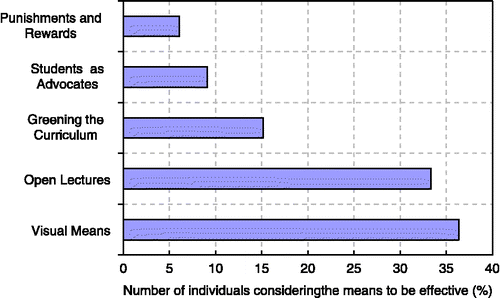
This would suggest that students feel that an incentive type of program would not have an effect. An explanation for these results could be that the interviewees were put off by having possible punishments. The word punishment instantly gives negative feelings and the survey may have revealed different results if ‘rewards’ were separated from ‘punishments’.
3.3 Student energy awareness scheme requirements
Requirements listed below have been created to aid the development of a student energy awareness scheme on which to base this investigation:
| • | provide a means to reduce energy consumption; | ||||
| • | provide an incentive; | ||||
| • | simple to understand; | ||||
| • | appeal/applicable to the whole student population; | ||||
| • | does not require extensive financial support; and | ||||
| • | easy to set up. | ||||
3.4 Energy awareness summary
To have the greatest effect on a student's energy awareness, students will have to be specifically targeted. Due to the financial status of most students, it was decided that a financial incentive scheme could have the largest effect on energy awareness.
This alone cannot reduce energy consumption among the student population. They will also require knowledge about what actions to take to reduce their energy consumption. There is little point in expecting students to pay for energy efficiency improving measures due to their restricted budgets.
They should be given tips and information about how to reduce their energy consumption. This information should be applicable to a student's day-to-day living and should be easily achievable. The students ought to have the biggest effect on their energy consumption. For example students are prone to leaving computers on; in some cases 24 h a day. If they could be persuaded to turn them off when not in use this would have a huge reducing effect on their energy consumption. Examples of the possible financial, energy and emission savings will also help increase their energy awareness.
4. Energy awareness trial in student houses
This trial aims to provide conclusive evidence that incentive schemes are the key to substantially reducing energy consumption within student accommodation. The purpose of this trial is to reduce energy consumption by as much as possible using the extensive research and ideas created from it.
Due to halls of residence on Loughborough University requiring permission to be utilised as a case study, students in rented houses were used for the study. The trial involved taking weekly gas and electricity meter readings for a 5-week period from 16 February to 23 March 2007. Eight houses participated in the trial. The residents of the houses were all undergraduate students aged 22–24.
4.1 Method
The trial consisted of two main parts; before and after the energy awareness ‘influence’. Gas and electricity meter readings were taken for 3 weeks to create a baseline. After this period the houses were influenced by energy awareness information. The main influence used to try and make the houses reduce their consumption was a £50 incentive. The house that reduced their energy consumption the most (as a percentage) would win £50 to share between all the residents.
Meter readings were then taken for the following 2 weeks during the ‘incentive’ period until the trial finished.
4.1.1 Recordings
The trial involved taking weekly gas and electricity meter readings from student houses for a period of 5 weeks from 16 February to 23 March 2007. Each house was given a form to fill in which detailed the exact time a reading was taken to allow for missed readings and alterations to the results if needed. A notes column was also included to allow the residents to write about any unusual occurrences that may have effected the readings during the previous week, e.g. extra/fewer tenants. These notes would allow for a detailed analysis providing an explanation for unusual results.
The houses were visited at the start, half way through and at the end of the trial to ensure that correct readings were taken.
During the whole trial period local external temperature recordings were taken during the morning, midday and evening every other day. These allow for the comparison of temperature and energy consumption as will be described in the issues section.
4.1.2 Questionnaires
Two questionnaires were given to the houses within the first 3 weeks of the trial commencing. Questionnaires were used as they provide a suitable way of extracting information in a standard format that can be compared at a later date. The information they supplied was used for explanations of results. A comparison of the trial population to the whole population by the use of these questionnaires will be discussed later.
The questionnaires were designed to be as short as possible to prevent the individual becoming bored and complacent.
The first of these aimed to capture the houses energy consumption characteristics.
A second questionnaire's purpose was to extract the individuals' energy efficiency and awareness. It did this in two ways; by asking the person's opinion and by trying to reveal it unknowingly.
A question asked the person to rate their energy awareness/efficiency and try to gain knowledge about the person's actual energy usage; further questions illustrate how energy aware the student actually is. This was done so that the results were as accurate as possible.
To allow the participants to provide feedback a questionnaire was collected from one resident in each house two months after the trial finished. It provided information about their perceived energy reduction during and post trial. There is also a section that gives information about the influence of each energy awareness measure. A comments section was included to allow for any feedback or suggestions.
4.1.3 Energy awareness influence
After the first 3 weeks the houses were visited again. At this visit the recordings were checked and the students were informed about a £50 incentive that they would receive if they reduced their energy consumption the most over the next 2 weeks. The houses were each left with a laminated information card that detailed the incentive, environmental issues that arise from consuming energy and possible actions they could employ to reduce their consumption. These guidelines were specifically targeted at students as explained in the energy awareness section previously. The card was designed to catch students' attention and get the energy saving message across. It does this by having a good balance of text and pictures and having all the information on one side of an A4 page. At the end of the trial period the houses were visited for the last time to retrieve the meter readings form. During this visit the final meter readings were checked and recorded.
4.2 Justification of reward
The £50 reward was chosen as it would be possible to retrieve that money in a real world case from the energy savings made in the trial. Average consumption and reduction data were used to provide an estimate of the possible amount of financial savings. The information used and calculations are shown below.
Results (2003) from the DTIFootnote4 ‘Regional and local use of energy in the domestic sector’ document estimate that UK households consume on average 4600 kWh electricity and 20,500 kWh of gas annually (Regional and local use of energy in the domestic sector Citation2007). With energy consumption of student houses being higher due to independent living and the high use of computers, this figure was increased by 10% to be more representative. The energy saving reduction estimate of 10% was taken from the Loughborough ‘Residential Halls Energy Efficiency League’ (Imago Services, Loughborough Students Union, Estates Services Citation2006). Therefore for a period of 2 weeks for eight houses:
4.2.1 Financial savings
Therefore, the financial savings made for all eight houses during the period of 2 weeks is estimated to be at least:
Due to the nature of the estimation this is a pessimistic amount which should easily be achieved. This would give a net financial loss of around £13. Due to the time restraints of this project a 2-week incentive was used. A period of 3 weeks would in theory have the same effects resulting in estimated savings of £55; giving a profit of £5.
4.2.2 Carbon dioxide emission savings
The CO2 emissions (Equations (Equation1) and (Equation2
)) allow the calculation of the predicted emission savings. The emission factors for natural gas and electricity used were 0.19 and 0.43, respectively (Available from: www.carbontrust.co.uk/resource/measuring_co2 [Accessed March 2007]).
Gas CO2 emission savings:
Electricity CO2 emission savings:
These calculations show that over 5 tonnes of carbon dioxide emissions could be saved in a year. That equates to driving 14,200 miles in an average sized family car (Simmons Citation2006). When less power is drawn from the grid in the UK, the fossil fuel power plants are turned off or reduced in times when the demand is reduced, whilst nuclear and renewable sources are kept on full as to meet the electricity base line. This means that the lesser the energy used, the more the effect it has on the carbon emission factor.
4.2.3 Temperature effects
The temperature will have an effect on energy usage within the home because heating may be altered accordingly. Since thermostats follow external temperature relatively closely there should be a strong correlation.
Met Office data show that there will be a change in temperature over the sample period as shown in Table (Available from: www.metoffice.gov.uk/climate/uk/stationdata/index.html [Accessed February 2007]). The readings were taken from Sutton Met Station which is within 4 miles of Loughborough.
Table 1 Average temperature during the trial period taken between 1959 and 2006 from Sutton met station (Available from: www.metoffice.gov.uk/climate/uk/stationdata/index.html [Accessed February 2007]).
During the experiment temperature recordings were taken within the area. This allows a correlation to be made between temperature and energy usage. These results could provide an explanation of changing energy usage.
4.2.4 Individuals environmental concern
It is hard to evaluate how proactive an individual is with regard to their environmental awareness. Household energy efficiency will be positively influenced by a resident who has very strong views about environmental issues that arise from energy consumption. This will be the case irrespective of any other factors. In such situations, reduction of energy consumption should not be expected because the residents may have been as efficient as possible prior to the incentive period.
4.2.5 Who pays the bills?
Not all the houses in the trial pay for their energy. It is becoming increasingly the case in student accommodation to have all inclusive packages that include utility bills. The lost financial implications as well as the reduced visibility of energy consumption will have negative effects on energy efficiency.
The questionnaire given to each household identifies houses with residents that do not pay for their energy bills, to allow for comparison.
4.2.6 Student maturity
This trial is aimed at undergraduate students who are at the edge of the population in terms of age. Since age is strongly linked to maturity such students may take the trial more seriously and make more of an effort.
The flip side of this argument is that less mature students may initially have poorer energy efficiency which would allow for greater savings to be made.
Due to this the results should not be assumed to be representative for the whole population.
This issue is looked at in the second part of the project which compares energy efficiency and awareness of those in the trial to the rest of the student population.
4.2.7 Loyalty
All the houses in the trial have some link to the author. Due to this, the residents may feel more obliged to make an effort during the trial period. Nothing can measure this effect but it should be considered in the conclusions.
4.2.8 Questionnaires accuracy
In today's society, it is generally frowned upon to be openly wasting energy and as such students may be unwilling and perhaps embarrassed to reveal their energy consumption behaviour. For this reason the questionnaires may not be accurate.
4.3 Results
To allow for the analysis and compatible comparison of results the completed forms were changed into common format. And gas readings, supplied in either cubic meter or feet, were converted into kWh.
The difference between each meter reading was divided by the number of days that elapsed between recordings. The results produced are for an average day during the week. This was done as not all meter readings were conducted on a weekly basics. The results in graph format are shown in Figures and . The dashed line shows where the incentive period started.
Figure 9 Electricity consumed shown on average per day for each week. (Figure available in colour online).

External temperatures graph is shown in Figure . The graph shows a substantial reduction in temperature during the last week of the trial. The effects of this are investigated further in Section 4.4.
4.4 Analysis
4.4.1 Individual results
To analyse the results properly any anomalies need to be considered. The notes section of the results form filled in by residents was evaluated for any instances that could affect the results; there were no periods where residents were away for a substantial amount of time.
The results from each individual house for gas and electricity are shown in the two sections below.
4.4.1.1 Gas results
To obtain the percentage change in gas consumption the average kWh usage per day was worked out for before and after the incentive. The difference was then converted into a percentage; the results are shown in Table .
Table 2 Average gas consumption before and after the incentive.
The results show that three houses have substantially reduced their gas consumption. Results within 5% could have resulted in natural deviations of energy use and this would account for the increases in consumption, represented by the minus values.
4.4.1.2 Electricity results
The same method was used to calculate the savings for electricity as was used for the gas. The results are shown in Table .
Table 3 Average electricity consumption before and after the incentive.
Again, the results that have around 5% difference can be ignored due to natural variances in energy usage. Four houses showed a considerable reduction in their electricity consumption.
Electricity savings of around 70% for houses C and G are large amounts. House C's results were questioned due to unusually high initial electricity consumption as shown in Figure . Their previous quarterly bill was analysed and it confirmed the high consumption. This was put down to excessive use of appliances within the house.
Investigation into house E's huge increase in consumption established that they found it difficult to gain access to their electricity meter. This meant that their electricity readings were sometimes taken at different times than what was recorded. This means that all house E's electric readings could be erroneous so they have been eliminated from the analysis.
4.4.2 Temperature allowance
As all the houses in the trial have gas central heating (discovered from the questionnaire), temperature will govern gas consumption. This is illustrated extremely clearly during the final week where average temperatures dropped to the lowest value for the whole trial. During this week the gas consumption rose considerably as shown in Figure . Although there was a rise in consumption during this week, the average was still well below the pre-incentive values.
To fully understand the temperature influence, graphs were produced. Figure shows that gas consumption is the inverse of temperature, i.e. as the temperature increases the gas required for central heating is reduced. This will affect results and needs to be considered.
Since the average temperature during weeks 3 and 4 was similar they could be compared. Table shows the results.
Table 4 Comparison of weeks 3 and 4.
As there was not a comparable temperature for week 5, analysis by other means was required. Using the assumption that temperature is linearly related to gas consumption the temperature and gas data for the first 3 weeks were extrapolated to provide a predicted value for the 4.78°C average temperature of the fifth week. This was done by creating a linear trend line from the temperature and gas consumption prior to the incentive period. Figure shows the graph used to create the trend line that produced Equations (Equation3) and (Equation4
). The equation allowed for estimated gas consumption during the fifth week if there had been no incentive. A percentage saving estimate is shown below:
To check this theory it was tested on the fourth week percentage saving results of 9.71%:
This shows that there is a small error margin of less than 0.5% in the theory. Wind levels that were not measured could explain this difference. If houses are poorly insulated high wind speeds will create larger and perhaps more drafts resulting in extra heating being required.
The big saving difference between 2 weeks (9.71 and 19.75%) during the incentive period could be explained by the students being able to be more efficient with their energy consumption during the colder spells. Turning off the heating when houses were empty would be an example of this.
The only way to conclusively explain this unpredictable correlation between gas and temperature would be to increase the length of the data collection period.
All of the temperature correction results were averaged to provide an improved savings figure. This provided a savings figure of 13.41%.
4.4.3 Combined results
Figure illustrates the overall savings for the houses gas and electricity consumption. It clearly shows the decrease in electricity consumption during the incentive period.
Table above shows that there have been substantial savings; on average, gas and electricity consumptions have reduced by nearly 20%. The following calculations work out the carbon emission savings from the 2 weeks:
Table 5 Total energy savings.
Gas CO2 emission savings:
Electricity CO2 emission savings:
If the houses continue this level of energy efficiency the trial will have reduced carbon emissions by 16 tonnes (the equivalent of nearly nine hot air balloons or driving 44,000 miles). This is three times the amount estimated in the justification of the reward.
4.4.4 Financial savings
Table shows the financial savings of each house during the period of 2 weeks.
Table 6 Total financial savings.
These results show that the £50 incentive has been justified by the financial savings. In fact, there is an £80 profit which is a suitable amount for such a small time period. It was discovered from the questionnaire that houses B, D and G were paying for an all inclusive package that included their gas and electricity bills. As discussed before this type of accommodation package is becoming more common within the student rental market. Not forgetting halls of residence accommodation which is entirely energy bill free. The results show that houses with these packages are among the least efficient. Students that have their energy bills paid for them are obviously less energy aware and therefore less energy efficient.
In a situation where energy bills are included in the standard rent charge it would be clearly financially viable for a landlord to set up a similar incentive scheme and actually make money.
4.4.5 Questionnaire feedback
Figure shows the participants' perceived energy reduction during and post trial. These results show that answers during the trial are similar to the post trial answers. This would suggest that the trial is still having a similar effect on the participant's energy reduction up to 2 months after it finished.
Figure shows what influenced the participants the most to save energy. The incentive method was clearly the favourite answer. This helps prove that an incentive method will provide the best energy saving results from a student population. The saving tips that were given to the participants on the information sheet also scored highly. Two participants thought that the relationship with the author had an effect on their energy saving. This factor although small, was overlooked when selecting the participating students. If a future study was to take place it is recommended to select participants who have had no previous contact with the project members.
4.5 Energy awareness questionnaire
To be able to fully analyse results from the energy trial the participant's energy awareness and efficiency need to be compared with the rest of the student population. To do this, a questionnaire was created that was very similar to the one given to students in the trial with the addition of age and year of study. This allows for comparison of the participants energy awareness and efficiency with that of other students.
4.5.1 Method
The questionnaires were distributed randomly to Loughborough University students. They have been completed by a range of ages to try and represent the whole student population.
4.5.2 Results
The results were converted into an excel file and graded with regard to the estimated effect on energy awareness and energy efficiency. Table details how each question was weighted.
Table 7 Questionnaire question ranking.
Since energy awareness does not directly affect consumption it was rated solely using perceived and energy knowledge questions. Energy efficiency depends upon a consumer's energy awareness, therefore all the questions were used to calculate energy efficiency. The greater the number, the more effect that question will have on energy efficiency, i.e. computer usage will have the greatest effect on energy efficiency as computers consume the greatest amount of electricity.
Students that participated in the trial appear to have superior energy awareness and efficiency (over 10 and 20%, respectively). The questionnaires were completed pre-trial so the results were not influenced. An explanation for the high levels of awareness and efficiency within the trial population could be the participants' background and level of maturity.
4.5.3 Analysis
Figure illustrates that there is a 40% increase in energy awareness as students get older. However there is no conclusive trend to suggest that age has an effect on energy efficiency.
Figure 16 Chart showing the average energy awareness and efficiency of the student population and the trial.

These results would suggest that greater savings could be made if an incentive method was conducted on a student without these characteristics. In Loughborough halls of residence the majority of students are in their first year of study and are in the 18–19 year age bracket. If a similar incentive scheme was installed in student's halls of residence the 20% saving figure should easily be matched if not increased.
5. Conclusions
Results from the trial provide conclusive evidence that increasing energy awareness has a big reducing effect on energy consumption. The trial suggests that from within the student population 20% savings from gas and electricity can be easily attained by directly targeting students. There is the possibility to continue the project in the future. Gas and electricity meter legislation now requires sub-metering in accordance with ‘The Building Regulations, Part 2’ (Planning Portal Citation2007). This regulation states that every area within a building of over 500 m2 requires sub meters for gas and electricity. This means that there will be meters for approximately every 40 rooms in new halls of residence. Loughborough University is currently building new halls of residence that should have these meters in place. This would be a prime area to investigate further and prove the feasibility of the energy awareness scheme created in this project. Once proven to work, a similar energy awareness scheme could be easily set up within this new hall to reduce the energy consumption and provide a financial gain. If the project was to be continued an extended trial period would be highly recommended; more data would provide even stronger evidence that an incentive style scheme would work. This project has shown that students continue to save energy after the trial period. This means that the incentive period could be increased. If investigated further an optimum level of incentive versus length of incentive period could be achieved. This will provide the maximum amount of savings whilst keeping the incentive as low as possible.
Additional information
Notes on contributors
Mohamed G. Hassan
1. 1. Present address: The American University in Cairo, 113 Kasr El Aini St, P.O. Box 2511, Cairo, 11511, Egypt. [email protected]Notes
1. Present address: The American University in Cairo, 113 Kasr El Aini St, P.O. Box 2511, Cairo, 11511, Egypt. [email protected]
2. It is an approach to problem solving that views ‘problems’ as parts of an overall system, rather than reacting to present outcomes or events and potentially contributing to further development of the undesired issue or problem.
3. This thermal expansion (or static sea level rise) occurs at all ocean temperatures and is one of the major contributors to sea level changes during the twentieth and twenty-first centuries.
4. DTI Department of trade and industry that became part of the BERR UK Department for Business, Enterprise and Regulatory reforming in late 2008.
References
- Dahle , M. and Neumayer , E. 2001 . Overcoming barriers to campus greening: a survey among higher educational institutions in London, UK . International Journal of Sustainability in Higher Education , 2 : 139 – 160 .
- Energy Information Administration. Available from: www.eia.doe.gov [Accessed April 2007a]
- Energy Information Administration. 2007b. Available from: www.eia.doe.gov/pub/international/iealf/tableh1cco2.xls [Accessed April 2007b]
- Imago Services, Loughborough Students Union, Estates Services. 2006. Estates Services, Residential Halls Energy Efficiency League, Trial 2005/2006. Summary Report
- Hare , B. 2006 . “ Relationship between increases in global mean temperature and impacts on ecosystems, food production, water and socio-economic systems ” . In Avoiding dangerous climate change , 191 – 199 . Cambridge : Cambridge University Press . In
- Intergovernmental Panel on Climate Change . 2001 . Climate Change The Scientific Basis .
- Jones , C.D. 2003 . Strong carbon cycle feedbacks in a climate model with interactive CO2 and sulphate aerosols . Geophysical Research Letters , 30 : 1479
- Monbiot , G. 2006 . Heat, How to stop the planet burning 15 – 16 .
- Patz , J.A. 2005 . Impact of regional climate change on human health . Nature , 438 : 310 – 317 .
- Pearce, F., 2005. Cities may be abandoned as salt water invades. Conference of the International Association of Hydrogeologists, New Scientist, 16 April
- Planning Portal. Available from: www.planningportal.gov.uk [Accessed April 2007]
- 2007. Regional and local use of energy in the domestic sector. Available from: www.dti.gov.uk/files/file20328.pdf [Accessed March 2007]
- Schipper , L. 1989 . Linking lifestyle and energy used: a matter of time? . Annual Review of Energy , 14 : 273 – 320 .
- Simmons , C. 2006 . Domestic carbon dioxide emissions for selected cities
- WBGU Special Report, 2006. German advisory council on global climate change. Available from: www.wbgu.de/wbgu_sn2006_en.pdf [Accessed November 2006]
- Wu , C. 1979 . Teaching energy awareness by computer simulation
